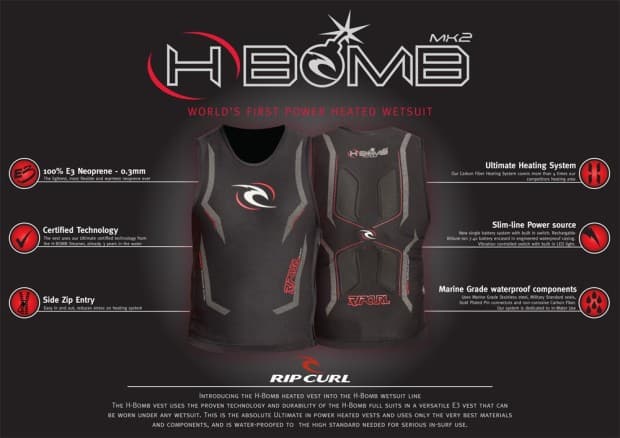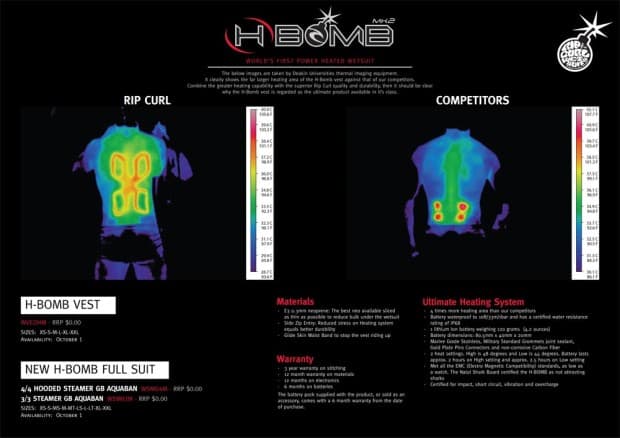A few years back Rip Curl materialized a probably quite old idea – heated wetsuit. A wetsuit that does not only protect you from the cold and conserves your body heat but also radiates its own heat to keep you warm. Worlds first heated wetsuit was Rip Curl H-Bomb and it came out in 2007. I don’t think it really caught on because it was and still is ridiculously expensive at around 1.000$.
Even though Rip Curl was plowing the field here Quiksilver came out with even a better idea – a heated vest that can go under any wetsuit at a price that won’t keep you warm just by looking at the price tag. Of course later Rip Curl followed with their own battery powered vest and as far as I know today we have four heating options out there:
- the original Rip Curl H-Bomb Heated Wetsuit
- Quiksilver Cypher Heated Vest
- Rip Curl H-Bomb Heated Vest
- Thermalution Heated Vest
So why is a vest better than a wetsuit? It won’t brake your bank and it’s even more useful that a wettie. You can use it with any wetsuit you want and turn it into a heated one. Loose a mm or two and gain some flexibility in not so cold water or make surfing the ice cold ocean possible.
I’ve used the Rip Curl H-Bomb Heated Vest for two winters now and this is my first hand review.
Rip Curl Heated Vest
When I got it, it looked like I’ve bough a piece of some high-tech super secret technology. A flat black box that contains the vest, rechargable battery and a charger. There are also different power plug adapters so you can charge it anywhere in the world. But it would be very cool if you could charge it in your car (they promised this is also coming).

Vest is made out of Rip Curls Elasto neoprene but it’s very thin. Because the heating wires should not be folded, pulled on or damaged in any other way there is a side zipper that makes putting the vest on easier.
Heating panels
Heating panels on the back cover a much bigger area than those in the Quiksilver heated vest which is good. The logic behind placing the panels is:
- your back is the straightest part of your body so this is where the panels are the most out of the way and at the same time in close contact with your skin,
- here is where the kidneys are and blood comes closest to the surface where it is heated by the panels. Heated blood, heated core, happy and warm surfer.
So both – QS and RC vests have panels on the lover back on top of your kidneys but RC reaches higher up. In reality the lower part of the panels is usually a bit loose against your back so the heat from the upper part of the heating system which is pressed firmly against you is felt better.

Where are the batteries?
There is a small side pocket with a cable to attach the battery. You put the battery into the pocket and zip it. Battery has a large button which operates the heating and can be in theory pressed and turned on with wetsuit gloves through the wetsuit neoprene and through the vest neoprene.
In reality you don’t always know exactly what you are pressing but most of the time you hit the right spot. There are 2 power settings: Low and High. How long will it keep you warm?
- On low about 2 and 1/2 hours and
- on high 1hr and 50mins.
Testing The Heated Vest
I have used the vest 10-20 times so far. My 3/2 is so old and stretched out I didn’t dare to try cold water + 3/2 + heated vest combo. I always had it with my 5/3 Matuse Tumo (check out the review of this wetsuit). The coldest session was probably 48-50F/9-10C water, air temperature about the same, moderate to strong wind. I wouldn’t need the vest for the water temperature alone but the wind chill factor is a pain in the ass.
Did the vest work? Yes!
When you turn on the heating on land you can feel the heat almost right away, it gets quite hot. Once in water the heat is not that obvious. It’s more a feeling like there is a pillow pressed against your back or that the sun is constantly shining on you from behind. I usually use it on low because it lasts longer and because I am not that cold to put it on high.
While wearing it your whole body feels comfortable. I won’t say you feel warm but you don’t get any of the cold water effects like numb feet and fingers and you stay flexible and explosive instead of all frozen up and slow like a sloth. Maybe 15 minutes after the batteries died the cold started creeping in and the difference was obvious.
I could use the low mode in water colder than 48-50F/9-10C and with high mode I would dare to go almost anywhere :).
One more detail maybe – does the battery bother you when surfing? No. You can feel it but you soon forget it’s there.
The Final Verdict
I love it. It doesn’t bother you, since it is a sleeveless vest you don’t loose any flexibility and it keeps you warm.
Where to buy it?
You can find it here.
If you have any other questions about this vest – ask, if you have something to share – share :)!
If you want to learn more about which wetsuit goes with which water temperature and what are the factors that influence the feeling of cold check this article.